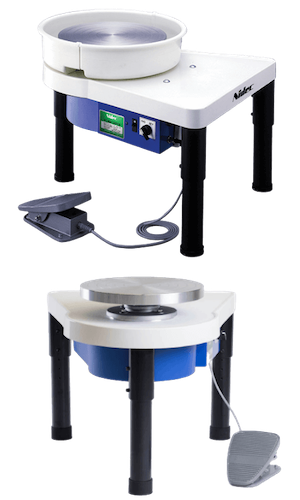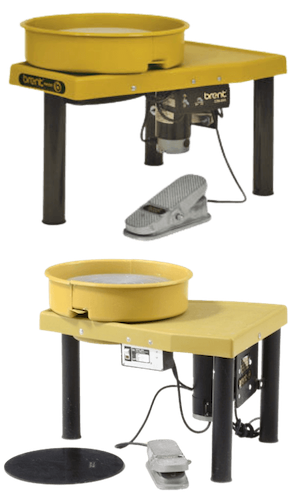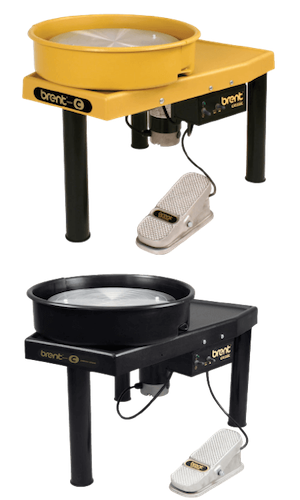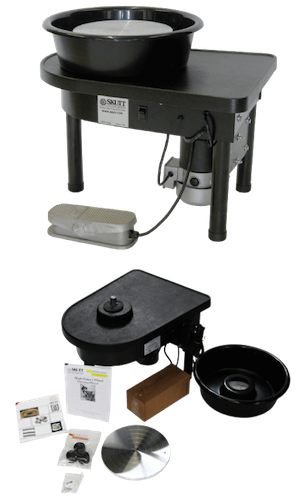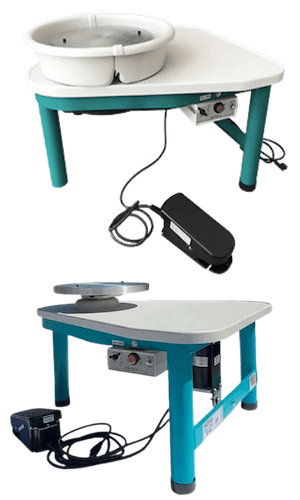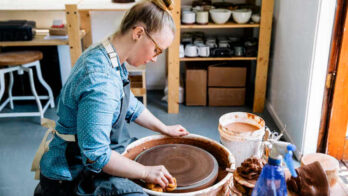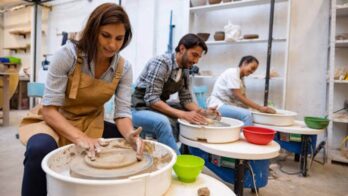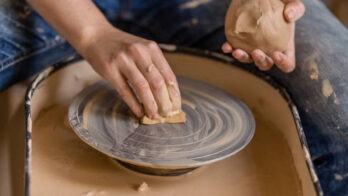Thinking about buying a pottery wheel, but not sure where to start? If that’s the case, you are in the right place! So keep reading and check out our reviews and buyer’s guide on the best pottery wheels for beginners.
A pottery wheel is one of the most important pieces of equipment for anyone who wants to make pottery. No matter if you’re a weekend warrior or a full-time professional potter, having a reliable pottery wheel will make your life easier.
There are a lot of excellent pottery wheels available on the market to suit a variety of budgets. However, determining which pottery wheel is the most suitable for you can be difficult.
So how do you choose the best pottery wheel? What features do you need to look for? What do you need to know before you buy one?
Choosing a Pottery Wheel for Beginners
To better understand how to buy the best pottery wheel, let us look at the most important factors you should consider while weighing up your options.
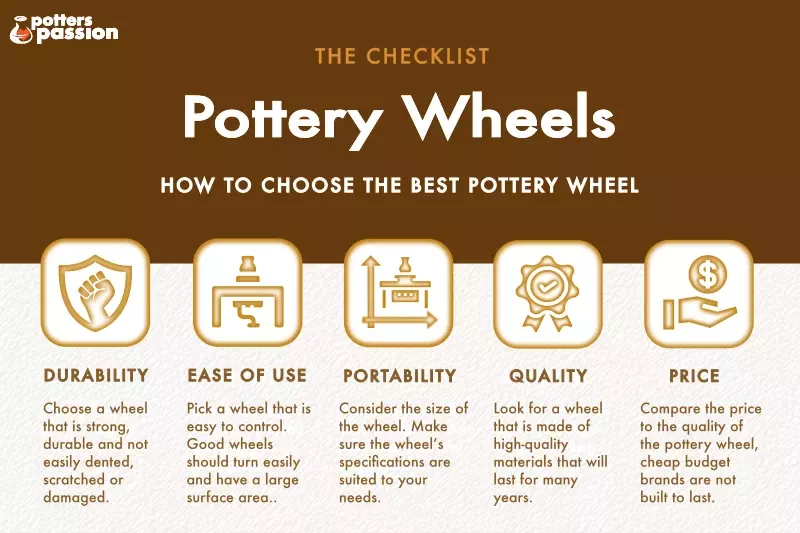

Reliability & Longevity
A potter’s wheel, together with your kiln, is arguably one of the most important pieces of equipment in your studio. So when purchasing a potter’s wheel, it’s better to stick with well-known pottery wheel brands such as Shimpo, Brent, Speedball, and Soldner, which have a long history of success.
They aren’t the cheapest option, but they are definitely worth the investment because they are built to last for years, not just a few months.




How Long Do Pottery Wheels Last?
Electric wheels have a 10-year average lifespan when properly maintained. However, a kick-wheel can last indefinitely with proper care.
Workspace & Portability
Having studio furniture that is easy to move around is important for most potters. Take into account the possibility of moving into a larger studio in the future, as well as the likelihood of you remaining in your current one or not.
Having a wheel that you can readily transport offers the possibility of delivering live demonstrations at shows, craft fairs, or festivals. So ensure to measure up and take a look at all of the possibilities and see which one works best for your own personal preferences.
Quality & Price
Price ranges for pottery wheels are determined by a variety of factors, such as size and the technical features included. Investing in a reliable, high-quality pottery wheel is essential and will save you money in the long run.
How Much Is A Pottery Wheel?


Pottery wheels range in price $500 to almost $1800. However you can pick up a pre-owned model from an online marketplace for considerably less.
If you are just starting out or are thinking of taking up pottery making as a hobby, there are plenty of low-cost options available under $500 through online retailers such as Amazon. However, it’s difficult to tell who makes these wheels because they’re frequently unbranded and available from various sellers.
Trust us on this, don’t waste your money on one of these poor-quality potter’s wheels. You should save that money and use it to buy even the most affordable wheels on our list. Everybody hates to waste money, but you most certainly get what you pay for with potter’s wheels.
The Best Pottery Wheels – Our Top Picks
If you are looking for a new wheel for your home or studio, our list below is a great place to start. Make sure you check out the details of each of these pottery wheels to ensure you select the one that will best meet your specific needs.
1. Shimpo VL-Whisper Pottery Wheel
The Nidec Shimpo VL-Whisper is aptly named as it’s currently the quietest wheel on the market. With the 14″ alloy wheel head, it centers up to 100lb (45kg) of clay. Another bonus feature of this wheel is the 2-piece splash pan, which allows easy cleaning after use.
- Currently the quietest electric pottery wheel available on the market.
- This model boasts a 14″ alloy wheel head.
- Centers up to around 100lbs (45kg) of clay.
- The VL-Whisper offers five adjustable height options.
- Removable legs for storage, travel, or tabletop use.
- The ½ HP reversible motor runs at speeds from 0-250rpm.
Also, this durable wheel is powered by a direct drive ½ HP beltless, brushless motor with a running speed of 0-250rpm, and it’s also reversible, making it ideal for left or right-handed potters. The electronic foot pedal controls the wheel speed, and when running at 0 rpm, the wheel will turn freely, allowing it to be used as a banding wheel.
Nidec Shimpo VL-Whisper Specs
| Motor (HP) | 1/2 HP, 400w |
| Speed (RPM) | 0-250 |
| Wheel Head Diameter | 14″ |
| Dimensions | 23.2 x 27.5 x 22.75″ |
| Reversible | Yes – Switch |
| Centering Capacity | 100 lbs |
The VL-Whisper has three removable legs so that it can be used on the floor or as a tabletop wheel. The adjustable legs also mean it becomes very compact and is easily transported or stored away.
The five adjustable height options (11″ 18″ 19″ 20″ 21″) are yet another great feature of this Shimpo pottery wheel and make this wheel perfect for everyone, regardless if you’re an adult or a child.
Our Verdict
The VL-Whisper is compact enough for small spaces; however, it is robust and big enough to create large pieces. It is very easy to assemble and really easy to clean. Also, the speed of this pottery wheel makes it a suitable pottery wheel for beginners or professionals and is ideal for a classroom or any studio space.






- Pedal response is excellent, and it’s simple to maintain.
- Quite possibly the quietest wheel on the market.






- There aren’t any major drawbacks to this wheel, though some skilled potters may prefer a more powerful motor.
2. Brent Model B & C Power Wheels
Brent offers a selection of sturdy, dependable wheels with various belt-driven motors. A Brent model pottery wheel is made to withstand daily use, and the Poly V Belts have been a firm favorite among schools and art centers for more than 40 years.
The bright yellow Brent pottery wheels feature heavy-duty construction, are belt-driven, and have a toggle switch that allows the wheel to go forward, reverse, or neutral.
They both have high-quality foot pedals which offers the best performance when it comes to controlling the speed. Both models are made to the highest quality, so let’s take a look at the differences.
Brent Model B
Model B is Brent’s entry-level wheel. It is very popular with schools and art centers. The model B has a 12″ wheel head and a full surround splash pan. It’s powered with a ½ HP motor and has a speed range of (0-240rpm).
- Powered by a ½ HP motor.
- Centers around 150lb (68kg) of clay.
- Heavy-duty all-steel construction with durable polyethylene table.
- Optimal torque for a smooth response when changing speed.
- Easy to use toggle with forward, reverse and neutral.
- Aluminum foot pedal with a speed range of (0-240rpm).
It centers around 150lb of clay and has an easy-to-use classic toggle controller to change direction; it also has automatic belt tensioning, meaning the belt will always remain tight, giving optimum performance. The aluminum foot pedal offers precise speed control. If you feel this model does not have enough motor power for you, you should check out the Model C, which has a bigger motor at ¾ HP.
Brent Model B Specs
| Motor (HP) | 1/2 HP |
| Speed (RPM) | 0-240 |
| Wheel Head Diameter | 12″ |
| Dimensions | 21 x 28 x 21.5″ |
| Reversible | Yes – Switch |
| Centering Capacity | 150 lbs |
Brent Model C
The Brent C model boasts a powerful ¾ HP motor. It centers around a whopping 225lb (102kg) of clay. When the wheel is running at full speed, the steel construction will remain stable, even when fully loaded. Changing speed is simple with the classic toggle control with forward, reverse and neutral options.
- Very powerful ¾ HP motor.
- Centres around 225lb (102kg).
- The 14″ wheel is made from aluminum.
- Heavy-duty all-steel construction with a durable polyethylene table.
- Optimal torque for a smooth response when changing speed.
- Easy to use classic toggle with forward, reverse and neutral.
It has a 14″ aluminum wheel head, and a high-quality aluminum foot pedal that runs at a speed of 0-240rpm. The steel legs are powdered, making them more durable and less likely to erode or be scratched.
Brent Model C Specs
| Motor (HP) | 3/4 HP |
| Speed (RPM) | 0-240 |
| Wheel Head Diameter | 14″ |
| Dimensions | 21 x 28 x 21.5″ |
| Reversible | Yes – Switch |
| Centering Capacity | 225 lbs |
This wheel was built to be dependable, long-lasting, and to be used daily. It is a little more expensive than the Model B; however, it is more powerful and very competitively priced. The perfect wheel for all potters, colleges and studios.
Our Verdict
Brent pottery wheels are great examples of everything you should expect from a pottery wheel. They are strong, durable and well constructed. This, partnered with their precise speed control and reputation for being dependable workhorses, only leaves us with one question: which of these Brent wheels meets your budget and needs?






- If you take good care of them, these wheels should last a lifetime.
- Brent wheels are heavy-duty, reliable, and easy to operate. If you can, buy one!






- Not ideal for those on a tight budget, especially those just starting out.
3. Speedball Clay Boss Potter’s Wheel
The Speedball clay boss is a perfect pottery wheel for beginners and professional artists alike. It has a 14″ plastic-coated steel wheel head, surrounded by a 2-part splash tray and a sturdy steel frame. Even though this is a budget-friendly wheel, it is well built and will last for years to come with proper care.
- Powered by a ½ HP industrial motor.
- Centers up to around 100lbs (45kg) of clay.
- Boasts a 14″ wheel head made from steel.
- The foot pedal allows variable speed control.
- 2-part splash pan making it easy to clean.
- Two pottery bats are also included with this wheel.
The tabletop is made from durable polyethylene, making it easy to clean. It has a foot pedal allowing variable speed from (0-24rpm) and also a reversible switch making it ideal for left or right-handed potters. Having a reversible switch lets you change the wheel direction quickly and easily.
Speedball Clay Boss Specs
| Motor (HP) | 1/2 HP |
| Speed (RPM) | 0-240 |
| Wheel Head Diameter | 14″ |
| Dimensions | 21 x 26 x 19.5″ |
| Reversible | Yes – Plug |
| Centering Capacity | 100 lbs |
The load sensing control ensures the wheel head speed will be maintained. The wheel centers around 100lb (45kg) of clay, and because the clay boss is a compact and lightweight wheel, it’s easy to move around and transport to pottery classes and craft fairs, etc.
Our Verdict
The most attractive thing about the Speedball Clay Boss has to be its budget price tag. Designed for beginners and suitable for hobbyists, the 2-piece splash pan and polyethylene tabletop make them both easy to clean, meaning more time crafting and less time cleaning up.
This budget wheel is a good pottery wheel for beginners, it is easy to assemble, and two pottery bats are included, so you will be ready to start immediately.






- Solid construction and very easy to operate.
- It is simple to move and transport due to the wheel’s compact size and weight.






- A bit noisier and lighter than the rest of the other pottery wheels on our list.
4. Skutt Thomas Stuart Prodigy Wheel
The Skutt Thomas Stuart Prodigy potter’s wheel has a 12″ aluminum twist and lift wheel head and 10″ bat pins. These are tough, well-built wheels with powder-coated sturdy steel frames to help stop erosion and prevent scratches. It has a vacuum-formed tabletop that is waterproof and easy to clean.
- 12″ twist and lift wheel head.
- Powder-coated welded steel frame.
- Plastic vacuum-formed waterproof tabletop.
- One-piece removable round splash pan.
- 6 Groove drive belt helping the motor run smoother.
- Heavy-duty cast aluminum foot pedal.
The prodigy boasts a 1/3 HP continual duty motor and a poly v-6 groove drive belt. It also has a heavy-duty cast aluminum moveable floor pedal. Although this model does not offer a reverse option, it does run smooth and is relatively quiet wheel.
Skutt Thomas Stuart Prodigy Specs
*Note that Skutt does not provide RPMs or Centering Capacity.
| Motor (HP) | 1/3 HP |
| Speed (RPM) | – |
| Wheel Head Diameter | 12″ |
| Dimensions | 24 x 24 x 30″ |
| Reversible | No |
| Centering Capacity | – |
It also has a removable one-piece splash pan and wheel head, allowing you to clean them thoroughly. This is a very good pottery wheel for beginners and the more experienced potter, and as well as being good for studios, they are also a good choice for the classroom.
Our Verdict
With all the features of the prodigy, it’s easy to see why it’s a popular choice. They are reliable, well built and have a good reputation. It’s so easy to clean with the 12″ aluminum removable head and, of course, the removable one-piece splash pan.
They run smooth and quietly, powered by the 1/3 HP continual duty motor. However, with this model not having a reverse option, it may not be the ideal choice for everyone.






- This pottery wheel is powerful, robust, and quick to respond.
- It can handle a lot of clay, which is helpful if you’re working on a big project.






- It is not easily moved due to its weight and you cannot reverse the wheel’s rotation either.
5. Pacifica Glyde Torc 400 Pottery Wheel
The Laguna Pacifica Glyde Torc 400 has a welded frame made from steel bolted onto a durable vacuum-formed tabletop. The wheel head is 13″ and made from aluminum with a 2-piece removable splash pan surrounding it, making it easy to clean.
- Centers up to around 80lbs (36kg) of clay.
- ½ HP electric motor with a speed of 0-260rpm.
- Separate speed adjustment ranging between 200-300rpm.
- 13″ wheel head made from Aluminium.
- Ultra-responsive, water-resistant foot pedal.
- Detachable splash pan helps keep the wheel clean
This wheel has an easy-to-access reverse switch, which is great for left and right-handed potters. The structure is strong and stable, and with state-of-the-art electronics, this wheel will ensure smooth rotation even when it’s running at a low speed.
The modular construction means it can be easily repaired if there should ever be a problem, and the push-button circuit breaker (which will stop the motor overheating) saves playing around with fuses.
Pacifica Glyde Torc 400 Specs
| Motor (HP) | 1/2 HP |
| Speed (RPM) | 0-260 |
| Wheel Head Diameter | 13″ |
| Dimensions | 31 x 27 x 20″ |
| Reversible | Yes |
| Centering Capacity | 80 lbs |
The Pacifica 400 centers around 80lbs (36kg) of clay and has a large workspace. There is also a separate speed adjustment which allows between 200-300rpm. It has a built-in foot pedal, and the foot pedal is water-resistant.
Also, it is very quiet compared to many other wheels, and as it’s constructed from an all-steel frame, it’s not too heavy. It’s no wonder this wheel has been rated as one of the best value wheels on the market.
Our Verdict
It’s a sensible choice for amateurs and experts alike. With its all-steel rigid structure, its 13″ wheel head and large work area, and its reverse switch making it compatible with left or right-handed people, it’s easy to see why many schools choose this wheel.






- The pans are simple to remove and clean after use.
- The load sensor adjusts the drive current to maintain a constant speed.






- Sits a little bit lower than most other pottery wheels, so you might need a leg extension kit.




How Much Setup Is Required?
Most potter’s wheels arrive fully assembled. Some may need you to put on the legs, but for the most part, you will simply attach the splash pan, plug it into a regular three-prong household outlet and go!
Buying Guide: Key Features to Consider in a Pottery Wheel
Before investing in a good pottery wheel, make sure you do your homework and figure out exactly what features you require. Understanding what you actually need will help when you start comparing the different pottery wheels available.
Wheel Motor
Nowadays, most potters choose to work with an electric wheels, which needs a motor to keep the wheel turning. The motor must be powerful enough to keep the wheel spinning fast. You will also be able to center more clay depending on how powerful your motor is.
The horsepower of a motor can be used to determine the overall power of the wheel. Electric pottery wheels generally have a horsepower rating of between 1/4 and 1 1/12. It’s great to have more horsepower on hand. However, if you are not planning on throwing big quantities of clay, you will not need to buy an expensive motor.
Speed (RPM)
The speed at which the wheel can rotate is measured in rotations per minute (RPM). The majority of motors can turn at least 240 RPM, which has an impact on the amount of torque that the motor can send to the wheel.
In general, the greater the torque of an electric pottery wheel, the more weight of clay it will be capable of supporting. Not every manufacturer, unfortunately, will supply this information.
Wheelhead Size
The wheel head of a pottery wheel is the part of the wheel that revolves and is where you throw your clay onto. Wheel heads are available in a variety of shapes and sizes, as well as various configurations. A flat circular metal surface with a diameter ranging from 8 to 14 inches is the most frequent type. Bat pins are located on most metal wheel heads and are used to secure the bat to the wheel head.
The size, quantity, and arrangement of bat pins can differ across wheel heads. Consequently, if you already have pottery bats that you want to keep using, you’ll need to hunt for wheels that have wheel heads that accommodate the precise pin configuration of the pottery bats you’re already using.
The diameter of the wheel head affects the size of the ceramic pieces that can be thrown, so your wheel head should be at least as large as the size of the item you plan to throw, such as large pots or any pottery with a wide base.
Foot Pedal or Lever
Some potter’s wheels are designed to be operated by hand. They will feature a lever or a toggle situated on the side of the wheel’s body. The speed of the wheel head can be adjusted by pulling on the lever.
Other wheels are controlled by a foot pedal, with the potter using their foot to adjust the wheel’s speed. The speed at which the wheel rotates is controlled by a foot pedal on most pottery wheels. Having good control over the speed is vital because you must constantly alter the RPM when shaping the clay.
First and foremost, you want to determine whether the foot pedal is fixed or if you can move it. It is best to have a movable pedal since it allows you to choose whatever foot you wish. Secondly, check the sensitivity of the foot pedal. Tiny motions result in large RPM changes if the pedal is overly sensitive and vice versa.
Centering Capacity
The centering capacity of the wheel defines how much clay can be loaded onto it at once. If you exceed this limit, the wheel may spin at a too slow rate, or the wheel may begin to accelerate and repeatedly decelerate at random intervals.
To choose a wheel with sufficient centering capacity for your projects, you must first estimate the amount of clay you will be putting on the wheel. A wheel with a centering capacity above 20 lbs would be a waste of money for most hobby potters, and a less expensive wheel might accomplish the job just as well.
However, you might want to work on larger projects in the future. This means that you should get a wheel capable of handling more clay than you currently use.
Weight & Dimensions
Most wheels are approximately the same size and form, with slight variance across manufacturers. The size of the motor and frame structure both impact the wheel’s weight.
A lighter wheel is easier to move, whereas a heavier wheel is more stable. The way you want to utilize the wheel and the size of your studio will determine whether you require a light or heavier wheel.
The Splash Pan
A splash pan is positioned around the wheel to capture water while throwing. Strangely, splash pans is often not included in the purchase price, even though you cannot use a wheel effectively without one.
So, double-check whether or not you will need to purchase a splash pan separately. Additionally, if the pottery wheel includes a splash pan, you should determine whether it is removable and whether it has a drain plug. It will be much easier to clean if it has one.
Reversibility
Most pottery wheels these days come with a handy switch that allows you to reverse the direction of the pottery wheel motor, enabling you to throw either clockwise or counter-clockwise, depending on your preference.
Potters who are right-handed generally find it much easier to throw when the wheel spins counter-clockwise, and left-handed people find it easier with the wheel spinning clockwise. This is because there will be times when you will want to change directions.
Some potters, for example, throw their pots with the wheel turning counter-clockwise and finish their pots with the wheel turning clockwise. However, the lack of a reverse switch on a potter’s wheel does not necessarily rule out the possibility of using one.
Alternatively, if a particular model does not come with a reverse switch, you will have the option of purchasing a left- or right-handed model at the point of purchase.
Leg Extenders & Risers
Free-standing wheels have three legs designed to be placed on the ground. Extenders are available from some manufacturers that fit over the legs’ ends, allowing a wheel to be converted into a standing wheel.
You may find it easier to throw this way because of the less strain on your lower back. Make sure to look at Shimpo wheels like the VL-Whisper, which has detachable legs so it can be used as a tabletop wheel.
Warranty & Customer Support
Check out the after-sale support for any potter’s wheel you are thinking of buying. How long is the warranty, and does the company provide post-sale support? Most local pottery suppliers are happy to address any questions if you purchase your wheel from them.
Over the years, I’ve found that pottery suppliers are really helpful. My local provider is always willing to assist me if I have a technical query or concern. The people that work at your pottery supplier are worth getting to know. The knowledge and assistance they provide can be quite beneficial.
What is a Pottery Wheel?
The term “pottery wheel” refers to a fast-turning turntable used to form clay into rounded objects, pots, and decorative items. Pottery wheels come in electric and manual varieties, each with its own advantages and disadvantages.
Kick wheels are manual pottery wheels that use momentum and a flywheel to spin the clay instead of electricity. For centuries, potters have used kick wheels, similar to spinning wheels, including a big flywheel at the bottom propelled by the user’s foot.
Electric pottery wheels can be operated by a foot pedal, buttons, or a panel. Whether you’re looking to spend a lot or a little, some models will feature an integrated seat, while others will sell alongside matching stools. The majority of wheels will also feature a splash pan, as throwing pottery is a messy activity.
How do Pottery Wheels Work?
A pottery wheel is just a spinning round platform. In addition to the wheel itself, a splash pan fits around it to catch water and clay as the wheel rotates. Pottery wheels come in electric and manual versions, as well as various sizes. If you’re feeling particularly adventurous, you might try creating your own DIY pottery wheel.
Many of them have attached seats, which ensures that you are sitting at the appropriate level. Potters wheels are used to create a wide variety of pottery items, including bowls, flower pots, and urns, among others.
Electric pottery wheels are the most popular type of pottery wheel nowadays. With the foot pedal, you can increase the wheel’s speed when you apply pressure to it. The wheel is supported by a frame that is approximately waist-high.




Can You Use An Extension Cord With A Pottery Wheel?
If using an extension cord, make sure it is sized correctly. A general rule of thumb – is never to plug a larger diameter cord into a smaller diameter extension cord. Make sure the wire size is the same on both.
As you work with the clay, you sit in front of the wheel and bend forward to make contact with it. As long as there is continuous pressure on the foot pedal, the wheel will continuously turn. The potter shapes the clay into the piece he intends to create as the wheel turns.
Each step in creating pottery items will require a specific speed for the wheel to spin. It will be spun relatively slowly by the potter as they center the clay and much faster as they raises the clay height. All the time, they are soaking or sponging the clay to get it to work.
How to use a Pottery Wheel
The learning curve for using a pottery wheel is rather steep. The ultimate objective is to place the clay on the wheel and center it so a pot can be formed. Don’t give up if your initial attempts aren’t that great; practice makes perfect, after all. Here are a few pointers to get you going if you’ve never used a pottery wheel before:
- You must begin by stocking up on necessary materials. To make pottery, you’ll need a wheel, a sponge, and some clay. Before you start using your pottery wheel, be sure to look over the manual.
- The next step is to get your clay ready. To begin, dilute the clay with water until you can roll it out easily. You should then knead the clay until it is smooth and easy to work with.
- When the clay has reached the proper consistency, you can begin shaping it. You must center the clay on the wheel before you can start. The next step is to shape the clay into a cylindrical form using your hands.
- You can begin turning the wheel when the clay has been formed into the desired form. While it is spinning, you can shape the clay with your hands. As your skill with the pottery wheel improves, you’ll have greater freedom to experiment with various forms and sizes of your pieces.
Find out how to use a pottery wheel by watching this great tutorial from Timsee Clay’s YouTube channel.
What’s the Difference Between Electric & Manual Pottery Wheels?
Manual wheels (kick wheels) function in the same way as electric wheels, except that the potter controls the rotation speed. There is a separate wheel at the bottom of the frame that the potter turns with his feet. The faster he needs the pottery wheel to turn, the more quickly he must move his feet.
Some potters prefer to use this process, and kick wheels are still in production today. However, you can’t just power up the motor and plow through the clay-like you can with electric wheels.
To be able to throw pottery and kick simultaneously demands practice, coordination, and a thorough understanding of how the two are intertwined. Check out our post Pottery Kick Wheel vs. Electric to see which is best suited for you.
What Type of Clay Should You Use on a Pottery Wheel?
Clay that is smooth and flexible is the best pottery clay for beginner potters. Moderate water absorption, good shape retention, and strength after firing are all important considerations.
Stoneware clay possesses all these properties, making it a very good choice for beginner potters. It’s important to be careful when choosing pottery clay because it could affect how you learn about the art.
How to Store & Maintain Your Pottery Wheel
When you’re starting to learn about pottery making, it’s important to ensure that your pottery wheel is in good working order and that you’re using it safely. Taking good care and cleaning your pottery wheel is necessary to ensure it lasts a long time. Here are some tips to get you started:
Essential Pottery Wheel Care


- After every session, make sure to thoroughly clean the area because clay gets everywhere. Making wheel cleaning a part of your daily maintenance routine is a good idea because clay is easier to clean up when it is still wet. Pay close attention to the space between your wheel mount and the pottery wheel head.
- When you find that excess clay is building upon the pedal of your pottery wheel, wipe it away with a damp cloth. A dirty pedal can be difficult to regulate and can completely devastate your efforts if not maintained properly.
- Your pottery wheel should have an almost silent and low-pitched motor. If you start hearing strange noises, it’s time for a thorough clean and oil. Clay dust can build up inside the motor after being used for a long time. Your local pottery supply store should be able to fix and maintain your motor for a reasonable price.
- If you don’t plan to use your pottery wheel for a while, cover it with a sheet or drop cloth. Every few months or so, you should plug in the wheel and move the pedal a little to keep its motor functioning well.
- Make sure your pottery wheel isn’t plugged in when it isn’t being used. If your pottery wheel has an on/off switch, turn it off.
Pottery wheels are known for their long lives. However, from time to time, you may encounter some issues. Check out our post on pottery wheel troubleshooting tips, and find out some of the common issues you could run into and how to fix them.
A Note on Buying a Used Pottery Wheel
You can save a lot of money by purchasing a used pottery wheel, and if you look carefully, you might even be able to locate one in virtually brand-new condition.
However, you need to use caution when making your buy. So before you go out and purchase a used pottery wheel, let’s go over the five most important aspects you need to be aware of first.
Try Before you Buy
Before investing in a used pottery wheel, you should thoroughly inspect it and see how well it works, just like you would with any other pre-owned item. You can learn a lot about the general condition of the wheel from just a few photographs.
However, it isn’t easy to estimate how well the wheel will function until it has been powered on. Therefore, even if you locate a used wheel online, you should always inquire with the seller about the possibility of coming over to try out the wheel before making a purchase.
Look Into the Warranty
The warranty on a decent pottery wheel is usually between 5 and 10 years. You should ask about the warranty of the used wheel you’re considering purchasing. The wheel is a safer investment if the seller is willing to provide you with the warranty.
If the wheel turns out to be faulty, fixing it won’t cost you very much. Used wheels can be great deals, but if the warranty has ended or missing, you’ll need to inspect it well before purchasing it.
Identify the Type of Wheel you Need
There is a wide selection of wheels to pick from, but not all are created equal. Many inexpensive wheels are small, have a limited clay capacity, and are prone to breaking. However, if you come across one of these wheels being sold, you might be tempted to purchase it regardless.
Because of this, I would suggest compiling a list of the models of pottery wheels that pique your interest and meet your needs.
Find Used Pottery Wheels
Good used pottery wheels are hard to find. Many of the wheels you find will be substandard, lack the necessary specifications, or be in poor shape. As a result, it is useful to have access to a wide variety of pre-owned wheels. You can start your online search at one of these websites:
- eBay
- Amazon
- Craigslist
- Facebook Marketplace
Alternatively, you can use your contacts to check if any friends or acquaintances have a wheel for sale.
Make Sure to Ask for a Discount
Now that you have managed to track down a good secondhand pottery wheel, you are prepared to finalize the deal. However, before you give over your money, it can be advantageous to try to negotiate a lower price. Most of the time, there is still some area for negotiation, and the seller might be prepared to take a lower offer.
So, What is the Best Pottery Wheel for Beginners?
If you’re just getting started, you should be able to find a wheel for under $500, but as I said before keep in mind that inexpensive models aren’t built to last as long as more expensive ones. Because of this, they can’t handle as much clay as a larger machine of the same size. This limits the pot sizes you can make.
You should consider investing in a high-quality wheel costing around $1,000 if you plan to use a pottery wheel frequently and want it to last. Our recommendation and favorite beginner pottery wheel is the Shimpo VL-Whisper, as it is easy to use and has removable legs that allow for tabletop use or a range of heights on the floor.
Summing Up
Purchasing a pottery wheel for beginners can be an overwhelming task. However, by considering your budget and the space you have available to set up your equipment and what kind of clay or art pieces you plan on creating with it, selecting a pottery wheel should become much easier.
Heres a quick round up – The Shimpo VL Whisper or the Brent C is, in my opinion, the best wheels available. The Shimpo VL Whisper is a good all-around choice for a first pottery wheel and is very quiet, whereas the Brent C has a lot more horsepower and can handle more clay.
So there you have it; I hope you found these pottery wheel reviews and buyer’s guide helpful and that you use this information to make an informed, confident decision about which Pottery Wheel you should invest in.
So don’t sit there and wait any longer. Go get that new pottery wheel and begin a fantastic journey of pottery creation!
Frequently Asked Questions About Pottery Wheels
Pottery studios can be in a garage, shed, or outdoor workshop. Good weather makes outside throwing fun. It connects you to air and ground, your clay’s source. Outdoor pottery is limited in a cold climate.
When wet, Air-Dry Clay has the same properties as a porcelain clay and can be thrown on a pottery wheel by more advanced potters. On the other hand, you must never put it through a kiln or use traditional glazes on it.
Your clay should be soft and sticky but not wet. It should feel like thick frosting when picked up. If you add too much water, wrap the bag’s edges and let it be exposed to the sun to evaporate some of the water.
Keep the stability of your potter’s wheel in mind while you play around with the height. This is crucial for your safety and also influences the quality of your final product. In addition to that, it must be level.
To throw a pot on a pottery wheel, a removable bat is not strictly necessary; yet, some potters like to work with one.
Although the company became known as Nidec-Shimpo Corporation when its name was changed in October of 1998, the branding remained the same.
Brent wheels are renowned for their strength and sturdiness and have been produced in the United States since 1969.



Enter your email below to get our FREE beginner friendly tips.
By entering your email address you agree to receive emails from Potters Passion. We'll respect your privacy and you can unsubscribe at any time.

